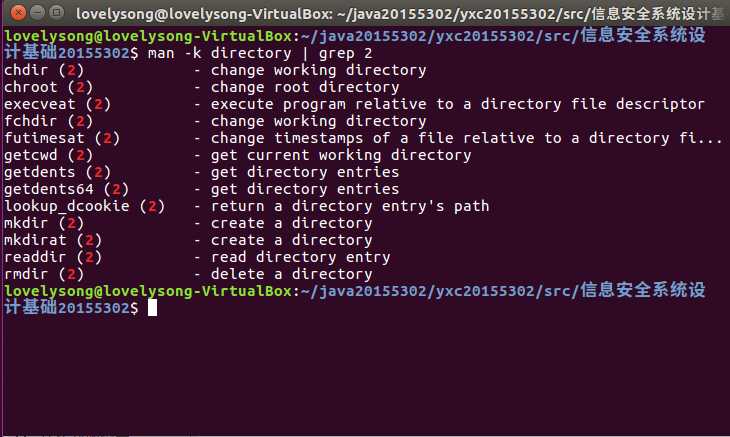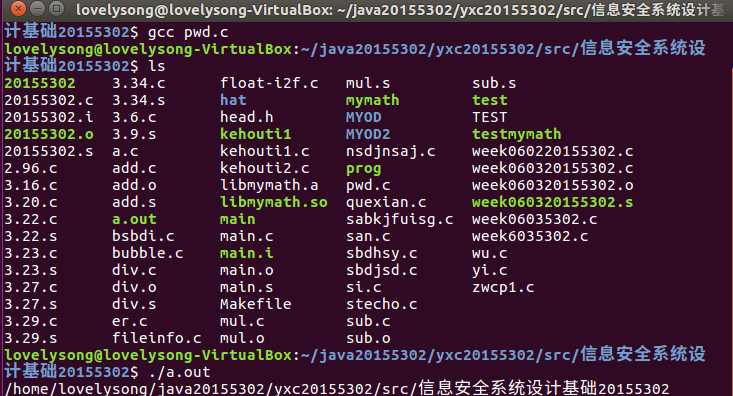标签:就是 main dep 选项 手册 argc close 显示 结构体
1:查看pwd命令的帮助信息man pwd
2:显示当前目录所在路径 pwd
3:显示当前目录的物理路径 pwd –P
4:显示当前目录的连接路径:pwd -L
‘pwd‘ 代表的是‘Print Working Directory’(打印当前目录)。如它的名字那样,‘pwd’会打印出当前工作目录,或简单的来说就是当前用户所位于的目录。它会打印出以根目录 (/)为起点的完整目录名(绝对目录)。这条命令是一条shell内建命令,并且在大多数shell中都可以使用,如bash、Bourne shell,ksh、zsh等等。
注意: ‘pwd’ 通常不带选项运行,且没有任何参数
重要: 运行的都是 “/bin/pwd” 而不是 “pwd”。
这有什么区别呢?直接使用“pwd”意味着使用shell内置的pwd。你的shell可能有不同版本的pwd。具体请参考手册。当你使用的是/bin/pwd时,我们调用的是二进制版本的命令。虽然二进制的版本有更多的选项,但是它们两者都能打印当前的目录。
man -k directory | grep 2可以寻找实现打印当前目录的系统调用函数

linux stat函数讲解
stat函数讲解
表头文件: #include <sys/stat.h>
#include <unistd.h>定义函数: int stat(const char *file_name, struct stat *buf);
函数说明: 通过文件名filename获取文件信息,并保存在buf所指的结构体stat中
返回值: 执行成功则返回0,失败返回-1,错误代码存于errno
相应伪代码:
根据文件名获取文件的inode-number
stat()通过文件名filename获取文件信息,并保存在buf所指的结构体stat中
根据inode-number, 在当前目录中查找对呀的文件名
opendir()打开一个目录,在失败的时候返回一个空的指针,成返回DIR结构体
readdir()用来读取目录。返回是dirent结构体指针
strdup()将串拷贝到新建的位置处,返回一个指针,指向为复制字符串分配的空间;如果分配空间失败,则返回NULL值
主函数中获取路径并打印mypwd代码:
#include <stdio.h>
#include <stdlib.h>
#include <dirent.h>
#include <sys/types.h>
#include <sys/stat.h>
#include <string.h>
#include <unistd.h>
#define MAX_DIR_DEPTH (256) //限制最大的目录深度
#define TRUE 1
#define FALSE 0
//根据文件名获取文件的inode-number
ino_t get_ino_byname(char *filename)
{
struct stat file_stat;
if(0 != stat(filename, &file_stat)) //stat()通过文件名filename获取文件信息,并保存在buf所指的结构体stat中
{
perror("stat");
exit(-1);
}
return file_stat.st_ino;
}
//根据inode-number, 在当前目录中查找对呀的文件名
char *find_name_byino(ino_t ino)
{
DIR *dp = NULL;
struct dirent *dptr = NULL;
char *filename = NULL;
if(NULL == (dp = opendir("."))) //opendir()打开一个目录,在失败的时候返回一个空的指针,成返回DIR结构体
{
fprintf(stderr, "Can not open Current Directory\n");
exit(-1);
}
else
{
while(NULL != (dptr = readdir(dp))) //readdir()用来读取目录。返回是dirent结构体指针
{
if(dptr->d_ino == ino)
{
filename = strdup(dptr->d_name); //strdup()将串拷贝到新建的位置处,返回一个指针,指向为复制字符串分配的空间;如果分配空间失败,则返回NULL值.
break;
}
}
closedir(dp);
}
return filename;
}
int main(int argc, char *argv[])
{
//记录目名的栈
char *dir_stack[MAX_DIR_DEPTH];
unsigned current_depth = 0;
while(TRUE)
{
ino_t current_ino = get_ino_byname("."); //通过特殊的文件名"."获取当期目录的inode-number
ino_t parent_ino = get_ino_byname(".."); //通过特殊的文件名".."获取当前目录的父目录的inode-number
if(current_ino == parent_ino)
break; //达到根目录,推出循环
/*两个inode-number不一样*/
chdir(".."); //更改当前工作目录,变为当前目录的父目录
dir_stack[current_depth++] = find_name_byino(current_ino); //"文件名"地址存放
if(current_depth >= MAX_DIR_DEPTH) //路径名太深
{
fprintf(stderr, "Directory tree is too deep.\n");
exit(-1);
}
}
int i = current_depth - 1;
for(i = current_depth - 1; i >= 0; i--) //打印路径
{
fprintf(stdout, "/%s", dir_stack[i]);
}
fprintf(stdout, "%s\n", current_depth == 0 ? "/" : "");
return 0;
}
pwd截图:

代码测试截图:

标签:就是 main dep 选项 手册 argc close 显示 结构体
原文地址:http://www.cnblogs.com/STILLlover521/p/7856627.html